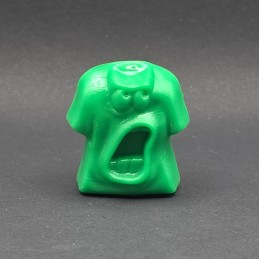




3 cm.
Loose.
Before Pokémon cards or Pogs, there were Jojo’s — tiny, colorful plastic figures that invaded schoolyards around the world in the mid-1990s. Created in 1995 by Laor Toys Ltd in Israel, these little collectibles quickly became a global playground craze.
The idea was simple: numbered mini “jacks,” molded into funny, expressive shapes, sold in mystery bags. Opening one felt like unwrapping a treasure. There were 36 original Jojo’s, each with its own personality, color, and texture — and some ultra-rare translucent or glitter variants.
In France, Jojo’s became a cultural phenomenon. Kids swapped, traded, and competed to get the rarest figures, turning every recess into a mini marketplace. Their quirky designs, wild expressions, and bright candy-like colors made them instantly recognizable.
Between 1995 and the early 2000s, new waves followed — including Barjo’s and Gogo’s — expanding the universe and keeping the frenzy alive. Today, sealed packs and rare editions are sought-after collector’s items, cherished by those who grew up during the toy boom of the 90s.
The Jojo’s represent the essence of 90s childhood: simple, fun, and a little chaotic. Just one small plastic figure could spark hours of laughter, trading, and imagination — proof that the biggest memories sometimes come in the tiniest packages.
 Rétro Vs Vintage : comment ne plus les confondre ?
Rétro Vs Vintage : comment ne plus les confondre ?
 Les odeurs de notre enfance dans les années 80-90
Les odeurs de notre enfance dans les années 80-90
 Nostalgeek Creepshow Jour-28: VALAK.EXE — La Sainte Machine
Nostalgeek Creepshow Jour-28: VALAK.EXE — La Sainte Machine

3 cm.
Loose.
check_circle
check_circle